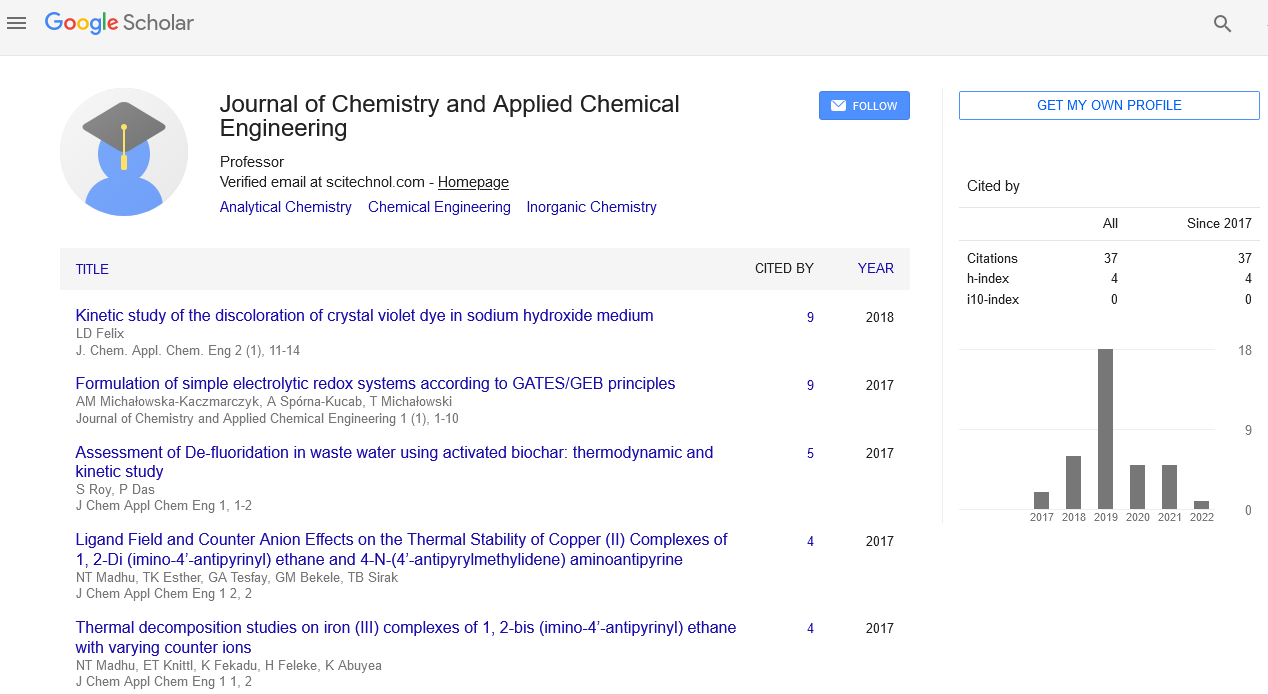Opinion Article, J Chem Appl Chem Eng Vol: 7 Issue: 3
Different Industrial Applications and Mechanism of Bioreactors
Thanwin Laopidan*
1Department of Biotechnology, Khon Kaen University, Khon Kaen, Thailand
*Corresponding Author: Thanwin Laopidan,
Department of Biotechnology, Khon
Kaen University, Khon Kaen, Thailand
E-mail: thanwin_lao.pi@gmail.com
Received date: 30 August, 2023, Manuscript No. JCACE-23-116791;
Editor assigned date: 01 September, 2023, Pre QC No. JCACE-23-116791(PQ);
Reviewed date: 15 September, 2023, QC No. JCACE-23-116791;
Revised date: 22 September, 2023, Manuscript No. JCACE-23-116791 (R);
Published date: 29 September, 2023, DOI: 10.4172/Jcace.1000033
Citation: Laopidan T (2023) Different Industrial Applications and Mechanism of Bioreactors. J Chem Appl Chem Engl 7:3.
Description
Bioreactors are essential tools in bioprocessing, serving as the heart of various industrial applications, from pharmaceuticals and biotechnology to food and biofuels production. These sophisticated vessels provide a controlled environment for the cultivation of microorganisms or cells, enabling the production of valuable biomolecules and products. Understanding the mechanism of bioreactors is crucial for optimizing these processes and achieving efficient, reliable, and cost-effective bioproduction. Bioreactors are specialized containers designed to provide a suitable environment for the growth and metabolic activity of microorganisms, plant cells, or animal cells. The central goal is to facilitate the efficient production of a desired product, such as pharmaceuticals, enzymes, biofuels, and more.
To ensure uniform mixing and distribution of nutrients and oxygen, agitators like impellers are used. Proper agitation is crucial to maintain optimal conditions throughout the bioprocess. Bioreactors feature temperature control systems to maintain a stable and controlled environment, as different microorganisms and cells have specific temperature requirements for growth and product formation. Maintaining the correct pH level is essential for optimal growth. Bioreactors employ pH sensors and control systems to regulate and adjust pH as necessary. Adequate oxygen is vital for cell respiration and growth. Bioreactors utilize spargers or gas distributors to provide the necessary oxygen. Sensors and control systems continuously monitor parameters like pH, temperature, dissolved oxygen, and biomass concentration, allowing for real-time adjustments and optimization.
Mechanism of bioreactors
Bioreactors provide a continuous supply of essential nutrients, including carbon sources (e.g., glucose), nitrogen, and other micronutrients, to support the metabolic processes of the cells or microorganisms. The efficient transfer of oxygen is essential, as most biological processes require oxygen for respiration. Oxygen is introduced into the bioreactor through spargers, and its concentration is carefully controlled to meet the specific needs of the culture. The pH of the culture medium is monitored and adjusted using acid or base addition to maintain an optimal pH level. Microorganisms and cells often have specific pH requirements for growth and productivity. Precise temperature control ensures that the culture environment remains at an optimal temperature for the microorganism or cells being cultivated. This enhances growth and product formation. Agitation systems, such as impellers, ensure the even distribution of nutrients, oxygen, and heat throughout the culture, preventing the formation of concentration gradients. When the culture reaches the desired productivity, the product is harvested.
Conclusion
Bioreactors are the unsung heroes of bioprocessing, enabling the efficient and controlled cultivation of microorganisms and cells for a wide range of applications. By understanding the mechanism of bioreactors and optimizing their operation, industries can produce pharmaceuticals, biofuels, enzymes, and other valuable products in a sustainable and cost-effective manner. Continued research and innovation in bioreactor technology are critical to advancing bioprocessing and meeting the growing demands of a rapidly evolving biotechnology landscape. Depending on the application, recovery methods like centrifugation, filtration, or chromatography are employed to isolate the target biomolecules.
 Spanish
Spanish  Chinese
Chinese  Russian
Russian  German
German  French
French  Japanese
Japanese  Portuguese
Portuguese  Hindi
Hindi 